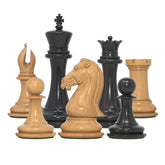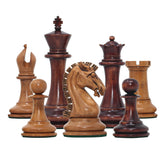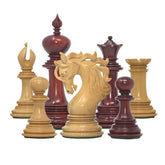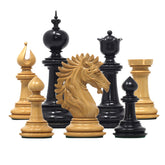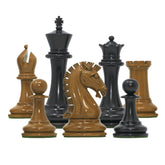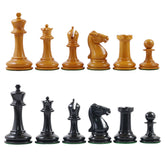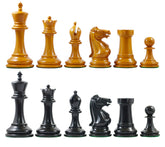The Real Value to Victory, Know Your Chess Pieces
As beginners, we are here to help you to know the real value of your chess pieces:
Queen - 9 points.
Rook - 5 points.
Bishop - 3 points.
Knight - 3 points.
Pawn - 1 point.
Here we go, Every chess player learns their chess piece's value early. This value system is one of the integral parts we must know if we are to avoid losing material.
One factor which you really need to know is that if a rook is worth five points and a bishop three points, you won’t exchange a rook for a bishop without considering other aspects. To know the worth of the chess pieces is the base of our play as beginners.
To know more, getting a steady grasp on the chess pieces is more essential and getting a genuine value for the chess pieces. To get the right kind of knowledge of your chess pieces’ value must get used wisely because sometimes the value gets increased and at other times it got diminishes as well.
This value system is pretty close to giving us a pragmatic idea of our chess piece's value. Because of the complexity of chess, there are other factors to be considered

In spite, these values, work well for beginners and are relevant for somebody only getting started in chess.
Do you know? Two rooks are somewhat stronger than a queen, and two bishops are stronger than a rook in an open position.
The New Chess Pieces Value Policy
According to research and American GM Larry Kaufman on the chess pieces value and suggested different parameters.
Queen - 10 points.
Rook - 5.25 points.
Bishop - 3.55 points.
Knight - 5.45 points.
Pawn - 1 point.
The new values deliberate a deeper understanding of chess. The two rooks remain slightly stronger than a queen or you can say that 10.5 points versus 10 points.
People always talk about a bishop-pair advantage, have you ever heard anybody mention a two knights advantage? Thus, it makes sense that the bishops were slightly higher than the knights. This new point strategy more precisely reflects the benefits of the bishop pair over a rook.
Interestingly, 6 points for two bishops over 5 points for a rook, we get 7.1 points for 5.25 points. The difference has increased from 1 point to 1.85 points.
Of course, beginners and many post-beginner players are going to struggle to get the most from having the bishop pair advantage. That is why the old values seem better to reflect the chess pieces’ value for beginners.
Placing a Value on Time in Chess
Time plays an important role in all the stages of a chess game. The gambit openings in chess are the best example of the value of time.
When playing the Wing Gambit, always be sure to secure the crucial e5-square to prevent …Qe5+, which wins the rook on a1.
The importance of time is simple to see in the openings, it plays an integral role in middlegame attacks and pawn races in the endgame as well. A single game can be the difference between earning a point and suffering defeat till you won the game.
You will feel more confident sacrificing a pawn and playing gambit openings if you keep track.
In the opening game, a player understands the importance of time by placing a value of 0.25 points on each tempo, which is a big help for all. Giving time makes the concept more clear and well in all ages of chess engines. This will benefit the player which make him quickly understand the next move.
The truth is that it can be extremely beneficial if you want a particular opening or you go for Gambit.
Another aspect is to know your queen while playing the Scandinavian Defense.
A wonderful gambit against the Sicilian Defense is the Wing Gambit. Enjoy the astounding victory by the white, including a double-bishop sacrifice. While playing the Wing Gambit, always be sure to cover the crucial e5-square to prevent …Qe5+, which wins the rook on a1.
Factors that Strike the Value of Your Pieces

The value of chess pieces is so simple to determine in an ideal world or balanced chess position. A queen is worth almost twice as much as a rook and all factors are equal.
This one question always strikes is Why do exchange sacrifices get played so often and what about other sacrifices?
The correct answer is by adding a few fundamental factors in determining the chess piece's value - The dynamic value of each piece.
One of the most straightforward factors to calculate is if your opponent has time to bring pieces over to defend their king. A sacrifice will definitely work when one of all his pieces is on the queenside, and you are attacking the kingside.
Few factors that scale down the chess piece's value
Tranquility:
Do the pieces encourage or help each other and defend or attack crucial squares?
Movability:
How effectively and lively are your pieces?
Development:
Are all your chess pieces in play?
Importance of Space in Chess
The significant value of your pieces is very much important, but it is not the only thing in chess. Do you know Maxime Vachier Lagrave showed us that mobility or activeness is an extremely important factor in chess?
In chess, all the relevant features of the game must work together if you are to have a good position. Mobility is made easier if you have more space because your pieces will not get in the way of each other.
For example, if your pawns have reached the fifth rank, you can use the third rank to develop pieces and the fourth rank to swing a rook or move a queen across the board.
Moving the pieces across the board is more difficult if your knights are developed to the third rank behind pawns on the fourth rank.
Of course, your rivals are likely to avoid exchanges if they have the space advantage. But most chess players learn early that the side with less space benefits from pieces to exchange.
Most importantly there are two other ways you can fight against the space advantage. You can use pawn breaks, and you can sacrifice a piece.
Sacrificing a piece is considered to be careful, but along with gaining you the living room, it will often earn you the initiative.
When you sacrifice the piece, be ready to obtain any mistakes your opponent might make due to the changes in the position.
In Conclusion of Chess Pieces Value

First of all, Think of these values as suggestions, and always remember to let the position guide you. The chess piece’s value is a crucial tool for every chess player, but it can become an obstruction.
One of the biggest drawbacks of going by a points system is becoming set in an object-oriented mindset. Playing gambits will help you learn the values like a lead in development and space.
Gambits can also help you to become more comfortable playing with material inadequacy. You don’t need to play them all the time or for an extended time.
Once you have realized yourself from a materialistic mindset, go back to playing more different types of openings. The lessons learned from playing gambits can teach you well in complex middlegames.
Hope you like this article FOR MORE INTERESTING CONTENTS DO VISIT OUR WEBSITE WWW.SATAUNTONCASTLE.COM


